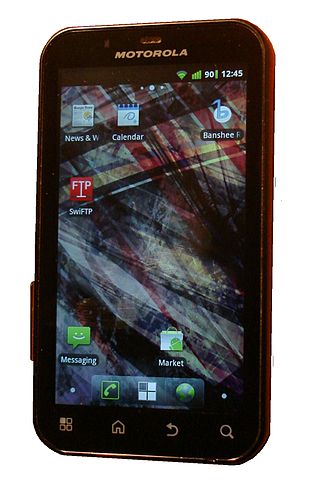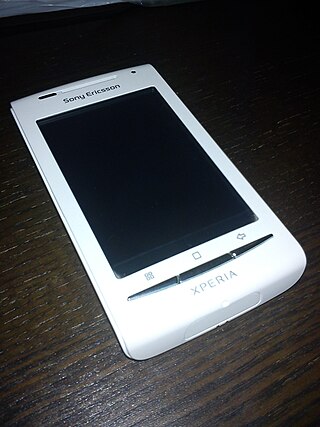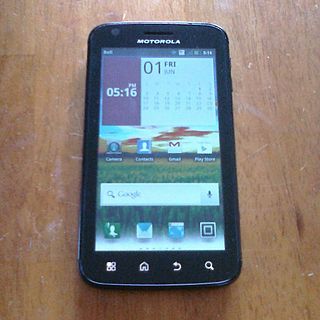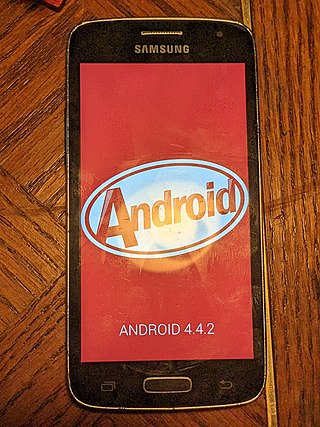A mobile operating system is an operating system for smartphones, tablets, smartwatches, smartglasses, or other non-laptop personal mobile computing devices. While computers such as typical/mobile laptops are "mobile", the operating systems used on them are generally not considered mobile ones, as they were originally designed for desktop computers that historically did not have or need specific mobile features. This line distinguishing mobile and other forms has become blurred in recent years, due to the fact that newer devices have become smaller and more mobile unlike hardware of the past. Key notabilities blurring this line are the introduction of tablet computers and light-weight laptops and the hybridization of the two in 2-in-1 PCs.

CyanogenMod is a discontinued open-source operating system for mobile devices, based on the Android mobile platform. Developed between 2009 and 2016, it was free and open-source software based on the official releases of Android by Google, with added original and third-party code, and based on a rolling release development model. Although only a subset of total CyanogenMod users elected to report their use of the firmware, on 23 March 2015, some reports indicated that over 50 million people ran CyanogenMod on their phones. It was also frequently used as a starting point by developers of other ROMs.

The HTC Aria is a smartphone manufactured by HTC Corporation that runs the Android operating system with HTC Sense.

The Motorola Defy (A8210/MB525) is an Android-based smartphone from Motorola. It filled a niche market segment, by being one of the few small, IP67 rated smartphones available at the time of its late 2010 release; it is water resistant, dust resistant, and has an impact-resistant screen. An updated version of the original model, Defy+ (MB526) was released in 2011. Other variants were also released before a revival of the Defy name in 2021.

The Sony Ericsson Xperia X8 is a mid-range 3G Android smartphone developed by Sony Ericsson in the Xperia series released in Q4 2010. It was sold in many countries worldwide, including the United States on AT&T Mobility and low-end pay-monthly contracts in the UK. It originally shipped running Android 1.6 but was upgraded in early 2011 to Android 2.1.

The Motorola Atrix 4G is an Android-based smartphone developed by Motorola, introduced at CES 2011 along with the Motorola Xoom, Motorola Droid Bionic, and Motorola Cliq 2 on January 5, 2011. It was made available in the first quarter of 2011.
The version history of the Android mobile operating system began with the public release of its first beta on November 5, 2007. The first commercial version, Android 1.0, was released on September 23, 2008. The operating system is developed by Google on a yearly cycle since at least 2011. New major releases are announced at Google I/O along with its first public beta to supported Google Pixel devices. The stable version is then released later in the year.
The Samsung Galaxy R (Royal) (GT-I9103) is an Android smartphone that was announced by Samsung on August 10, 2011 as a variant to the Samsung Galaxy S II.

The Samsung Galaxy SPlus or Samsung Galaxy S 2011 Edition is an Android smartphone, introduced July 2011.

Sony Xperia L (C2104/C2105) is a Sony's budget oriented smartphone manufactured by Sony, announced in March 2013 and launched in May 2013.

The Sony Xperia Z1 is an Android smartphone produced by Sony. The Z1, at that point known by the project code name "Honami", was unveiled during a press conference in IFA 2013 on 4 September 2013. The phone was released in China on 15 September 2013, in the UK on 20 September 2013, and entered more markets in October 2013. On 13 January 2014, the Sony Xperia Z1s, a modified version of the Sony Xperia Z1 exclusive to T-Mobile US, was released in the United States.

AOKP, short for Android Open Kang Project, is an open-source replacement distribution for smartphones and tablet computers based on the Android mobile operating system. The name is a play on the word kang and AOSP. The name was a joke, but it stuck. It was started as free and open-source software by Roman Birg based on the official releases of Android Open Source Project by Google, with added original and third-party code, features, and control.

The OnePlus One is an Android smartphone manufactured by OnePlus. Unveiled in April 2014, it is the first product by OnePlus. The OnePlus One was designed to compare favorably – in performance, quality, and price – to flagship devices by leading smartphone manufacturers. It was also intended to be developer friendly, and has since received a wide variety of ROMs and custom kernels from the community. The OnePlus One shipped to most markets with the Cyanogen OS operating system pre-installed, a commercial variant of CyanogenMod.

The Samsung Galaxy Avant is a mid-range smartphone released by Samsung in July 2014. It was only available on the T-Mobile network in the United States, although it could be purchased both on and off contract. This phone retailed for $230, making it one of the cheaper offerings by T-Mobile. While the phone was praised for its low price and decent performance, it was also criticized for its poor screen and camera. The display was often cited as having washed out colors and a lack of sharpness, likely as a result of the TFT panel used. The Galaxy Avant received a few official software updates, but was never upgraded past Android KitKat.

Xiaomi Redmi 2 is a smartphone produced by Xiaomi released in January 2015. It is the successor to the Xiaomi Redmi 1 family.
Paranoid Android is an open-source operating system for smartphones and tablet computers, based on the Android mobile platform. The latest official version is Topaz, based on Android 13, released on 15 October 2022.

LineageOS is an Android-based operating system for smartphones, tablet computers, and set-top boxes, with mostly free and open-source software. It is the successor to CyanogenMod, from which it was forked in December 2016, when Cyanogen Inc. announced it was discontinuing development and shut down the infrastructure behind the project. Since Cyanogen Inc. retained the rights to the Cyanogen name, the project rebranded its fork as LineageOS.
Resurrection Remix OS, abbreviated as RR, is a free and open-source operating system for smartphones and tablet computers, based on the Android mobile platform. UX designer and head developer Altan KRK & Varun Date started the project in 2012.
crDroid is a customized fork of Android based on LineageOS. It is one of the first to offer unofficial releases of Android 10, Android 11, Android 12.1 and Android 13 Custom ROMs.













